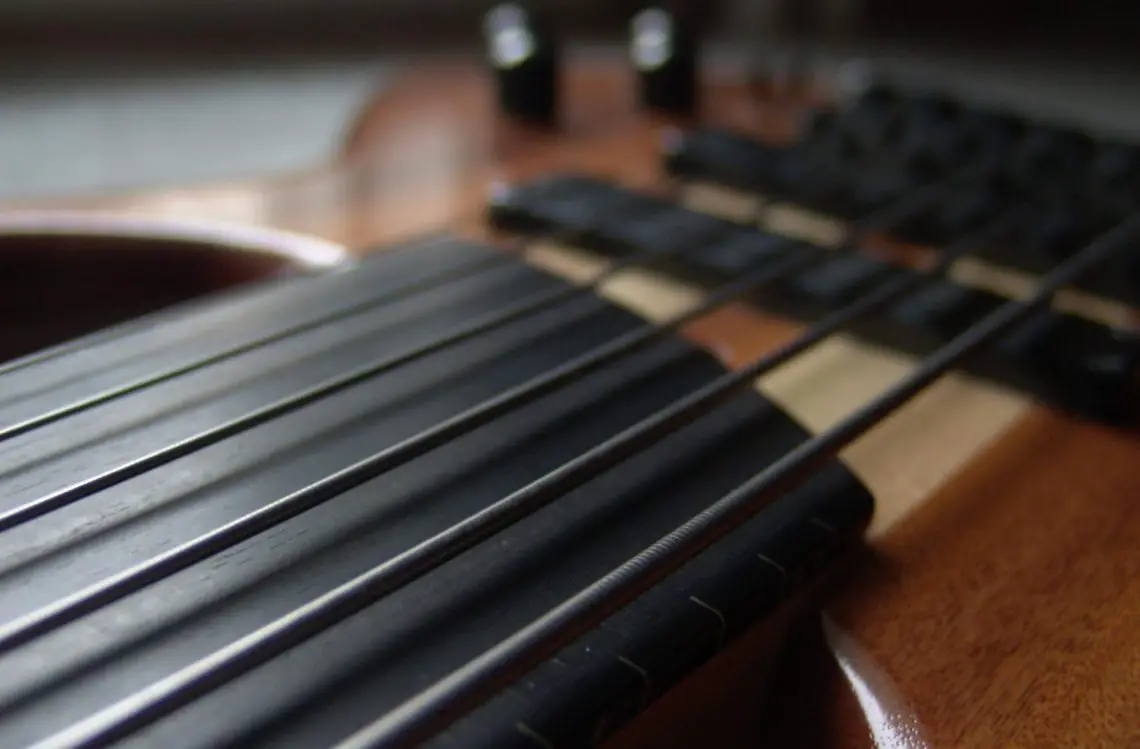Fretless basses are great for those who want a certain tone, easy slides, and accurate intonation. Acoustic bass guitars are perfect for musicians who need portability or for those who just enjoy acoustic music. A fretless acoustic bass is a very specific type of instrument that will not be for everyone.
If you are looking for this type of bass, the Godin A4 Ultra Natural Fretless SA is the best choice. This bass also comes in a 5-string model under the name Godin A5 Natural Fretless SA. Either version is a top-quality instrument that offers great value for the money.
-
 $799.99Check on Amazon
$799.99Check on AmazonThe satin finish on the body and neck give it a smooth feeling that's good for fast playing.
06/28/2025 09:10 pm GMT -
-
-
 Check on Amazon Check on eBay
Check on Amazon Check on eBayThis Acoustic-Electric features a stable, rock maple neck, an ebony fingerboard for bright tone, a solid spruce top for balance, and a 13-pin connector for guitar synth connections. Its has great volume and sound projection whether player electronically or acoustically.
-
 $399.00Buy Now Check on Musician's Friend
$399.00Buy Now Check on Musician's FriendHas a dual truss rod for extra neck stability.
06/28/2025 09:13 pm GMT -
-
In order to provide you with the best information, we put a lot of time and effort into our research. I started by contacting three local music stores. I contacted Guitar Center and Sam Ash first, to see what the big-box stores recommended. I found them to be very helpful, but their information seemed limited to models they currently had in stock. Next, I called a small, family-owned store. They let me speak to a gentleman who gives bass lessons there. I took down a small list of his recommendations.
I have played bass guitar myself for nearly 20 years. I focused mostly on electric, but also own acoustic models. I personally tried many models before making my own purchases.
Why Choose A Fretless Acoustic Bass Guitar?
In order to answer this question, let’s first take a look at the differences between fretted and fretless basses. For those new to the instrument, a fret is a metal wire in the neck of a guitar. When you press on the fingerboard behind a fret, the fret cuts off the string vibration at that specific point. This makes the correct note ring out.
Tempered instruments – One of the issues with fretted instruments is that they are never perfectly in tune everywhere on the neck- they are tempered. This means that they are tuned and intonated in such a way that they are equally off along the length of the neck. The theory is that it is better to be out of tune equally everywhere than perfect at one end of the neck and severely off on another. If the instrument is well-made, the amount it is off by will be so small that most will never notice.
Fretless basses do not have this problem. The player ends the string vibration by pressing on a specific place on the fingerboard. This means that you can even compensate for an out-of-tune bass in the middle of a song. If the string is sharp or flat, you simply need to move the spot you hold on the fingerboard to compensate. Fretless basses also make slide techniques a lot easier.
Pitch – A fretless bass allows for more musical freedom. Frets limit the pitches available to a player. They only allow for specific notes on the scale. With frets, you must always go from E to F. Without the frets, you can play every pitch between those two notes.
Tone – One reason to choose one over the other is the tonal difference of the instruments. A fretted instrument has a more sharp, crisp tone. They are often more rich with harmonics than a fretless model. Fretless basses tend to have less of an upper or mid-range tone. They have a much smoother sound. Which one works best depends entirely on your own personal taste and the style of music you play.
Difficulty – One thing to be aware of is that fretless basses are more difficult to play. You must be much more precise with your finger placement. If you are not precise with your finger placement, there will be intonation errors in your playing. It can be difficult to tell when you are slightly off, unless you have perfect pitch hearing. You must also apply more finger pressure with a fretless instrument. Playing fast is much easier with a fretted bass. Fretless basses are usually best for the more experienced player.
What To Look For When Choosing A Model
Acoustics Vs. Electrics
Now that we’ve established why someone might choose a fretless bass, let’s take a look at why an acoustic might be best for you.
Portable – Acoustics are great for portability. You can play them anywhere. You can take the acoustic with you outside for some practice in the fresh air. You can even take it camping or to the beach to entertain some friends in a small setting. You will not need to worry about power supplies and dragging an amplifier along with you. If you do want to play a gig in a medium to large venue, you can always mic the acoustic for more volume. Many models are acoustic-electric and provide the best of both worlds.
Tone – The next thing to consider is the tonal difference between an acoustic or an electric. Both types of bass guitar can sound great when played along with acoustic instruments. This is really a matter of personal taste. Acoustics lend themselves well to certain music genres, such as Delta blues, folk, country and bluegrass. If you like the sound of the classic, stand-up bass, a fretless acoustic does a great job of emulating that sound.
To get an idea of the sound differences check out these samples of a fretless acoustic bass and fretless electric:
Acoustic versus electric and fretted versus fretless are only two of the many considerations when buying a bass.
Acoustic-Electric – If you play music in a live setting, you may want to purchase an acoustic bass that also has pickups. These are referred to as acoustic-electrics and can be used with an amplifier for added volume. This can be invaluable when playing with a band, as acoustic basses may be hard to hear over other instruments. This can also allow you the option of using effects, such as reverb or chorus, to tailor your sound.
Scale – You should also consider the scale of the instrument. The standard scale, or long scale, is 34 inches. A short scale is 30 inches, while a medium scale is 32 inches. An extra-long scale is 35 inches. The length of the scale is measured between the nut and bridge.
The most common reason to choose a shorter scale would be due to the player’s stature. A younger player or anyone who has trouble reaching all areas of the neck will benefit from a shorter scale. Scale length can also affect string tension, feel and sound. Some players like the strings to have a loose feel. Short-scale instruments achieve that feeling because the strings need less tension to be properly tuned.
Body size and shape – affects the tone, volume and comfort of an acoustic bass. The larger the body, the more volume the bass will have. The downside is that it may make the bass uncomfortable to play. When making your choice, you may need to compromise here depending on which attribute is more important to you.
Strings – With any type of bass, you will always need to decide how many strings you wish to have. For most styles of music, a 4-string bass will be just fine. A 5-string or 6-string can provide you with more versatility and a greater range. If you like heavier music, a 5-string can be a great choice. It allows you to play more low notes without detuning the instrument.
Wood – The type of wood your bass is made of should also be a consideration. The idea of tonewoods has become something of a controversy in the guitar and bass community- focusing on electric instruments. The debate is over how much wood type affects the tone. One school of thought is that it makes a major difference. The other side claims that the sound is not produced by wood vibrations with an electric instrument and instead produced by the pickups sending a signal to the amplifier and the speakers. A third view believes that any tone differences are mostly negated by the amplifier and other equipment.
Do not let this controversy confuse you. When it comes to acoustic instruments, the wood makes all of the difference. You should usually choose a fretless acoustic bass guitar with a solid top. They will generally sound better. The top of an acoustic bass is called the soundboard. It affects the sound more than any other part of an acoustic instrument.
Acoustic basses are made of many different types of wood. Some of the most common are spruce, maple, basswood, ash, rosewood and mahogany. Spruce is rigid and provides a strong tone. Cedar has a responsive and warm tone. Rosewood and mahogany are usually considered the best for lower, warm and mellow tones. Most bass necks will be made with maple due to its strength and stability. The fingerboard may be made with maple, rosewood or ebony. These woods have aesthetic benefits, but also affect the tone and sustain. Many bass players believe that a rosewood fingerboard provides a warm, rock tone.
Price Versus Quality
The next thing to think about is the price versus quality. The saying, “you get what you pay for,” has generally been true of my own experiences. Many new players make the mistake of getting something cheap to learn on. They often believe that this is a good choice, since they will not be out much money if they give up on playing. The problem with this theory is that a poor-quality instrument often leads to new players giving up. If the bass is too hard to play, doesn’t sound good and can’t stay in tune, you are not very likely to keep practicing.
With all of that in mind, lower cost does not always mean cheap. Low-cost bass guitars keep getting better every year. A good bass guitar can still be found in the lower-to-mid price ranges. They may lack some of the bells and whistles of more expensive models, but should be just fine to learn on or even to gig with.
The key to making a good choice is to start with a realistic budget. If this is your first bass, buy the best quality one available in your price range. Do not fall into the trap of basing your decision on looks. I believe many new bass and guitar players make this mistake. You see a cool body shape or your favorite color and gravitate towards that instrument instead of ones that sound and play better.
Choosing a good brand can greatly increase your odds of getting a good instrument. Out of the fretless acoustic bass guitars I researched, the top seven models are from the following brands; Godin, Ortega, Boulder Creek, Michael Kelly, Kala, Dean and Gold Tone. Some of the other top brands include; Ibanez, Fender, Martin, Gibson, Epiphone, Taylor, Warwick and Alvarez.
Things To Check Before Making A Purchase
Once you select a model, there are basic checks you should do to make sure the instrument is free of any problems. These checks should be performed in the store before you complete a purchase. If you buy online, you should check the instrument thoroughly as soon as it arrives. Be sure to buy from reputable online dealers, so you can make a return or exchange if your bass has any issues.
Action – Check the action first if you are making your purchase in a store. The action is the height of the strings from the fingerboard. This can easily be adjusted. Most stores have an incentive to setup basses well because they want them to be easy to play. This makes it more likely they will be purchased. If the action is too high, this might indicate an issue that is preventing the bass from being set up properly.
Body – Check the body to make sure there are no dings, dents or paint chipping. Check the neck to make sure it is straight and not warped. Look down the neck from the headstock towards the bridge. Check to make sure the edges seem straight and that the neck is not twisted.
Electrics – If your bass is an acoustic-electric, plug it into an amp and make sure the pickups and other electronics work properly. Do not just play your favorite riffs when trying out the bass. Play every string up and down the entire length of the neck. Make sure that the notes ring out clearly everywhere and that there are no dead spots. Tap the top soundboard of the bass guitar in different spots. Listen carefully for any strange vibrating noises. This may indicate loose braces inside of the body.
Comfort – The most important thing to check is that the bass is comfortable to you. The feel of an instrument is subjective. Only you will know for sure what feels the best in your own hands. Bass necks come in a variety of different finishes and shape profiles. The same is true of acoustic bass bodies. Try as many different models as possible to see what works best for you.
Top Pick: Godin A4 Ultra Natural Fretless SA

Credit: Godin Guitars / Guitares Godin
Our recommendation for the best fretless acoustic bass is the Godin A4 Ultra Natural Fretless SA. There is also a 5-string model with a similar name. The exception is that it has an A5 designation instead of A4. Both models are otherwise identical.
This Acoustic-Electric features a stable, rock maple neck, an ebony fingerboard for bright tone, a solid spruce top for balance, and a 13-pin connector for guitar synth connections. Its has great volume and sound projection whether player electronically or acoustically.
This bass features a rock maple neck with an ebony fingerboard. The rock maple gives the neck strength and stability. The ebony gives it a sharp look and should make for a brighter tone. Bass necks often need to be adjusted a couple times a year, or when moving the instrument to a place with a different climate. This neck seems to remain stable no matter what.
Many owners claim that they rarely need to make adjustments to the truss rod. The neck has a soft C shape which makes for a comfortable playing experience. The top is solid spruce, which gives a balanced tone production. The silver-leaf maple body provides a clear tone and structural stability. The body is finished with a natural, semi-gloss and has black hardware for a classic look.
This model is acoustic-electric and sounds great played either way. It has great volume and sound projection when played acoustically. It features custom electronics with the highest quality components that Godin offers.
It has one Low Profile Lace Sensor electric pickup. This provides excellent sound quality when amplified. The volume and tone controls are mounted to the side of the bass for easy reach, while also staying out of the way of your picking hand. Godin’s custom preamp allows for a lot of control over your tone with bass, mid and treble adjustments. This bass features a dual-chambered body. This helps to cut out feedback when you play with an amp. The body is finished with a natural, semi-gloss and has
The tuners seem to be of excellent quality. The bass keeps in tune even after hours of playing. This fretless bass has the equivalent of 20 frets, a 16″ fingerboard radius and a 34″ scale. This makes it an excellent size for the widest range of players.
The most unique feature of this model is that it has a 13-pin connector. This means that you can connect it for direct control of Roland GR Series and Axon AX100 guitar synths.
Runner Up: Ortega Guitars
Our runner up is the Ortega Guitars 4 String Lizard Series Fretless Acoustic-Electric Uke-Bass. You can find it for sale online at this page. The fretless neck is lined to make it easy to hit the right notes. The body has a cutaway shape that makes it easy to reach the highest notes. This bass has a mahogany top for great tone.
Has a dual truss rod for extra neck stability.
The back and sides are made of mahogany for a warm, rich sound. The mahogany neck and rosewood fingerboard further add to the warmth of this bass. It has a dual truss rod for extra neck stability. Not only does this add to the stability, but it allows you to make fine adjustments to the neck relief in either direction.
The built-in tuner is a convenient feature that removes the need to carry a tuner with you.
More Choices To Consider:
Here are five more choices that are well worth your consideration. These fretless acoustic basses come in a variety of price ranges. You should be able to find something great for any budget.
EBR3-N4F
The Boulder Creek EBR3-N4 Acoustic-Electric 4-String Fretless Bass has a solid cedar top and mahogany back and sides for a deep, warm tone. The SBC bracing system allows the top to vibrate freely. This aids in sound projection.
Good tone, clarity and volume.
The body has a port on the top side that allows the player to better hear the instrument. This is very helpful when playing music with others. This bass has great tone, clarity and volume.
Dragonfly
The Michael Kelly Dragonfly Bass is a beautiful instrument with a quilted maple top and intricate fingerboard inlays. It comes in both 4-string and 5-string versions. It features Fishman electronics for the best sound when plugged into an amp. The acoustic tone is warm and rich with plenty of volume.
Constructed of high-quality materials and features Grover tuners.
It is constructed of high-quality materials and features Grover tuners. This is why it plays great and stays in tune so well. The neck is a set neck that provides great sustain. The neck has dual graphite reinforcement rods. This is great for neck stability. It also has a double adjustment truss rod for setting the perfect amount of neck relief.
U-Bass
The Kala U-Bass 4-String Fretless is a little different from the other models we have looked at. This is a compact, 21″ scale bass that is perfect for travel or portability – and is great for guitar players with smaller hands – you can do very long stretches on the short 21″ scale. The U-Bass is an acoustic-electric with great volume and acoustic tone. It really shines when used with an amplifier.
This bass actually has a tone similar to a full-size, stand-up bass. It’s great for practice and can be used to jam with other musicians when connected to an amp. The body is constructed of mahogany, which gives it a deep, full-bodied tone. The electronics are so good that it has an excellent live sound. The active equalizer lets you tweak your sound to fit in with any style of music.
Gold Tone MicroBass 25″
The Gold Tone 25″ Scale Fretless Acoustic-Electric MicroBass is another small-scale, portable bass. Like the U-Bass, it is perfect for travel and playing anywhere acoustically. It can also be used for live performances due to the Piezo Transducer.
Has a built-in tuner to keep you in tune without the need to carry extra equipment.
It has a built-in tuner to keep you in tune without the need to carry extra equipment. The nut and saddle are made with real bone for great tone and sustain. The bridge is made of rosewood for a warm sound. The neck, sides and back are all mahogany for deep, bass tones.
Ibanez SRH500F Fretless Acoustic-Electric Bass Guitar
The Ibanez SRH500F Fretless Acoustic-Electric Bass Guitar is a bargain. This model is the best budget-buy of all of the bass guitars that made our list. I personally spent some time with this model and ended up purchasing one for a relative who is new to playing bass.
The satin finish on the body and neck give it a smooth feeling that's good for fast playing.
This is a fine choice for anyone learning to play or for electric bass players who wish to try an acoustic. The trim and finish are not the best, but the sound and playability are top notch. It plays and sounds as well as instruments that cost twice this much. The satin finish on the body and neck give it a smooth feeling that’s good for fast playing.
Here’s a recap of the competition:
The satin finish on the body and neck give it a smooth feeling that's good for fast playing.
Has a built-in tuner to keep you in tune without the need to carry extra equipment.
This Acoustic-Electric features a stable, rock maple neck, an ebony fingerboard for bright tone, a solid spruce top for balance, and a 13-pin connector for guitar synth connections. Its has great volume and sound projection whether player electronically or acoustically.
Has a dual truss rod for extra neck stability.
Good tone, clarity and volume.
Constructed of high-quality materials and features Grover tuners.


















Start the discussion at talk.hearthemusicplay.com